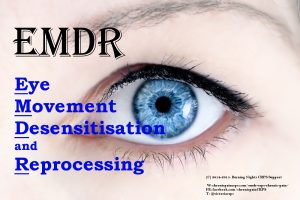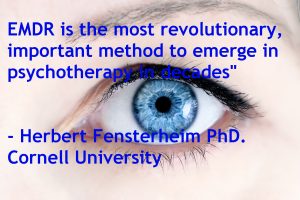We use cookies to improve your experience. By accepting you agree to our cookie policy
Eye Movement Desensitisation and Reprocessing, often shortened to EMDR, is used as a psychological treatment for various conditions, including Complex Regional Pain Syndrome (CRPS) and chronic pain. It is classed as a fairly new form of psychotherapy and it is often used as a treatment for Post Traumatic Stress Disorder (PTSD). There is some research available for EMDR as a treatment for CRPS or chronic pain, but the treatment is still considered controversial.
EMDR was originally designed by a psychologist by the name of Dr Francine Shapiro and is an 8 phase treatment. It was during a chance observation that she saw eye movements reducing the intensity of the person's thoughts after seeing her own stress reducing when her eyes moved side to side. (Anapsys website 2011)
According to the EMDR Institute Inc, EMDR is "…a psychotherapy that enables people to heal from the symptoms and emotional distress that are the result of disturbing life experiences."
Or, to break this down further, Helpguide.org in their guide on EMDR (2011) say that "EMDR involves recalling a stressful past event and "reprogramming" the memory in the light of a positive, self-chosen belief, while using rapid eye movements to facilitate the process."
EMDR is considered to include elements of cognitive behavioural therapy (CBT) along with some eye movements. It is considered a safe therapy with no side effects, making it useful for many conditions such as CRPS, chronic pain, PTSD, depression or anxiety. In EMDR, there is no talking therapy or any form of medication, but instead it uses "…a patient’s own rapid, rhythmic eye movements. These eye movements dampen the power of emotionally charged memories of past traumatic events." (WebMD)
In an average session of EMDR therapy, you will concentrate your thoughts on traumatic memories and any negative thoughts and feelings whilst watching your therapists' finger move from side to side or diagonally. (Helpguide.org)

According to WebMd, the actual way EMDR therapy works isn’t known, but there are theories that exist (Goldberg, J.). When there is a traumatic event in your life they get stored in your brain with sights, sounds, feelings and thoughts. The brain can then become unable to process the event because of the very strong emotions that interfere with the ability to actually process it. The goal of EMDR therapy is to reduce these traumatic events so they become less intense and can provide more coping mechanisms for use in day-to-day life.
In the study by Hughes, M (2014), she believed that one of the reasons why EMDR therapy helps and works for CRPS is "Because psychotherapeutic treatment is recommended for CRPS, and because physical trauma is a precursor in up to 90% of cases of CRPS, it is hypothesized that a psychotherapeutic intervention designed to address psychological trauma may be of benefit to patients with CRPS."
When the event is activated again, these memories cause a negative impact on daily life. The way EMDR works to help CRPS and chronic pain, according to Bartson, S. & Smith, M. (2011) on EMDR, is that "EMDR therapy appears to directly affect the brain, "unfreezing" the traumatic memories, allowing you to resolve them. Over time the disturbing memory and associated beliefs, feelings, sensations become “digested” or worked through until you are able to think about the event without reliving it. The memory is still there, but it is less upsetting."
It was also said in the study by Hughes, M (2014) that "EMDR can be an effective treatment of the trauma commonly associated with CRPS."
There is an 8 phase treatment for EMDR therapy that will address the past, present and future of any painful memories that have been stored. You are then asked to recall any traumatic events at the same time as receiving bilateral sensory input that is comfortable for you, which include either:
(Counselling Directory UK)
According to the review done by Shapiro, F (2014), "EMDR therapy provides physicians and other clinicians with an efficient approach to address psychological and physiologic symptoms stemming from adverse life experiences."
Each EMDR session can last from 50 minutes up to around 90 minutes and usually consists of 8 phases of treatment (Shapiro, F. 1989). You will be given a choice of having the bilateral sensory input either using tapping, auditory tones or side to side eye movements.
Boulware, C. (2006) states that "A typical EMDR session begins with the therapist gently guiding the client to pinpoint a problem or event that will be the target of the treatment. As the thoughts and feelings come to the surface, the therapist and client work together to re-direct the eye movements that accompany the briefly recalled experience. As the eye movements are re-directed, the accompanying emotions are released."
EMDR deals with 3 time periods - the present, past and future. The therapist will focus on past disturbing memories and any events relating to those memories. The focus will then be given to any current situations or problems that are causing you distress and then skills are developed as well as necessary attitudes for positive future actions. (EMDR Institute Inc)
The first couple of sessions are for taking your history and organising a treatment plan. It is in these first few sessions that your therapist will identify any memories, events, feelings or disturbing issues that will used as the focus for the EMDR treatment. The initial EMDR processing will usually focus on any childhood events, rather than adult ones. Length of treatment depends on the number of traumas and the age of the onset of PTSD, start of CRPS or chronic pain.
Before you begin EMDR for the first time, the therapist will ask you to find what is known as a 'safe place'. This can be a memory or an image that makes you feel comfortable and positive, such as a moonlight beach or the sun setting.
If a session does not fully complete or if you have a very distressing and upsetting EMDR session, your therapist will take you back to your'safe place'. Your therapist will also help give you other ways of dealing with your emotional distress by using stress reduction techniques and imagery that you are able to use both during the sessions and between them.
Your therapist will help you find a target image or memory that they will help you process using the EMDR procedure. This will involve 4 things:
Your therapist will ask you to simultaneously focus on the image, your negative belief and the disturbing emotion or any body sensations. You will then be asked to follow with your eyes the therapists' finger or object which will move from side to side, back and forth or diagonally.
After each set of around 20 eye movements, you will be asked to tell your therapist what has come up, which could be a physical sensation, a feeling, a thought, memory, image, any or no changes. There is no right or wrong in this. Then, your therapist will ask you to do the same as before but this time to focus on the image that has just come up.
Occasionally your therapist will tell you to think back to the original target image or on another image, feeling, thought, memory or physical sensation. Every so often you may be asked as to how much distress you are feeling. The Desensitisation phase will end when what is known as SUDS or Subjective Units of Disturbance Scale has reached either 0 or 1.
This stage is known as the Installation Phase and it is when you are asked about the positive belief that you would use instead of the negative belief of yourself or the image. Just like in Phase 4, you concentrate on the image in your head and watch your therapists fingers.
The idea behind this phase is so that you can strengthen the positive belief that you have said such as "I can do this" or "I will overcome the pain." After each set of eye movements, you will be asked to rate your Validity of Cognition (VOC) or the truth of your belief on a scale of between 1-7. When you have reached level 7 and accepted this positive belief then the installation phase is complete.
This is classed as the Body Scan phase. Once you have your positive belief in your mind, in this phase your therapist will ask you if you have anywhere in your body that is painful, any discomfort or stressful.
If you have, you tell your therapist and you will then be asked to concentrate on that pain, discomfort or stress and your therapist will start the sets of finger movements, tapping or bilateral sounds. This phase is complete and successful when you are able to think about the original problem or event without feeling any bodily pain, stress or discomfort.
This is the closure or debriefing stage in the 8 phase treatment. One of the main goals of EMDR therapy is that you leave better than when you arrived. You won't always be able to finish completely at the end of each session, so your therapist will give you some self control techniques to work through between the sessions.
Your therapist will also give you information as to what you may experience in between the EMDR sessions, such as disturbing images, flashbacks, painful emotions. If or when these happen, write them down in a diary to keep and show your therapist at your next EMDR session. It may give your therapist a new target for another session or help your therapist understand whether the EMDR is helping you with your targets.
The final phase is the Re-Evaluation phase. When you start each EMDR session, you will review the past week telling your therapist any new sensations. You will also review any targets that have already been processed.
Your therapist is hoping that your positive belief has been maintained. Depending on what happens during the re-evaluation, your therapist will decide on whether to start on a new target or to revisit an old target for more processing. An objective of this phase is to ensure that historical events have been processed.
Details for the 8 phases from the following sources: Bartson, S & Smith, M. (2011); Menon, S. & Jayan, C. (2010); Sweeney, P.

Websites and directories to help you find an EMDR trained therapist in your country:
Hopefully, this article on EMDR for CRPS and Chronic Pain has helped you understand another psychological treatment available in most countries worldwide for the symptoms of CRPS and of any other chronic pain condition.
Find out more about Psychological Treatments for CRPS & Chronic Pain
Would you try EMDR therapy for your Chronic Pain or CRPS? Let us know your thoughts! Why not share this page on social media?
